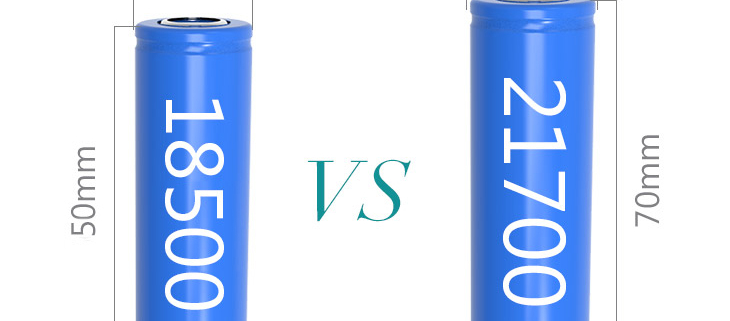18500 vs 21700 battery: what are the differences?
Selecting the appropriate battery type is essential for achieving optimal performance and efficiency in your device. The 18500 and 21700 are the two prevalent battery sizes. What distinguishes these batteries, and which should you choose based on your requirements? This article will examine the distinctions between the 18500 and 21700 batteries, delving into energy density, capacity, discharge rates, temperature stability, cycle life, and their potential applications.

Battery Basics
What are 18500 and 21700 batteries?
Both 18500 and 21700 batteries are cylindrical lithium-ion rechargeable batteries. The numbers refer to their dimensions: a 18500 battery measures 18mm in diameter and 50mm in length, while a 21700 battery measures 21mm in diameter and 70mm in length.
Battery Size and Capacity
Size and capacity are two essential aspects of batteries. Generally, larger batteries have higher capacities to store more energy. This is because a larger battery can accommodate more energy-storing lithium-ion cells.
18500 vs 21700 battery: what are the differences?
Energy Density
Energy density is the amount of energy stored per unit volume. It’s an important factor to consider when comparing batteries, as a higher energy density translates to longer runtime for a device. In general, 21700 batteries have a higher energy density than 18500 batteries due to their larger size.
Capacity
The capacity of a battery refers to the amount of energy it can store. It’s typically measured in milliampere-hours (mAh) or watt-hours (Wh). A higher capacity means the battery can power a device longer before recharging. As expected, 21700 batteries have a higher capacity than 18500 batteries because of their larger size.
Discharge Rates
Discharge rate, or the rate at which a battery can deliver power, is another important factor when comparing batteries. A higher discharge rate is desirable for devices that require more power. In general, 21700 batteries can support higher discharge rates than 18500 batteries.
Temperature Stability
Temperature stability measures how well a battery performs under various temperature conditions. Both 18500 and 21700 batteries have similar temperature stability, but specific models may perform better depending on the quality of the materials and construction.
Cycle Life
Cycle life refers to the number of times a battery can be charged and discharged before its capacity is significantly reduced. While 18500 and 21700 batteries have similar cycle lives, 21700 batteries tend to have slightly longer cycle lives due to their larger size and higher energy density.
Applications
Electric Vehicles
Electric vehicles (EVs) require batteries with high energy density, capacity, and discharge rates. As a result, 21700 batteries are the preferred choice for many EV manufacturers because they offer better performance and longer runtimes than 18500 batteries.
Portable Electronics
For portable electronics like smartphones, tablets, and laptops, both 18500 and 21700 batteries can be used. However, the choice depends on the device’s power requirements and design constraints. While 21700 batteries offer higher capacity, they are also larger and heavier, which may not be suitable for smaller, lightweight devices.
Power Tools
Power tools demand high discharge rates and capacity for optimal performance. 21700 batteries are often preferred for power tools due to their higher capacity and discharge rates, which provide longer runtimes and better performance.
E-cigarettes
E-cigarettes and vaping devices require batteries that deliver high discharge rates for optimal performance. 18500 and 21700 batteries can be used in these devices, but the choice depends on the device’s size and power requirements. While 21700 batteries offer higher discharge rates and capacity, they may not fit in smaller vaping devices designed for 18500 batteries.
Making the Right Choice
When choosing between 18500 and 21700 batteries, consider the specific requirements of your device, such as energy density, capacity, discharge rates, temperature stability, and cycle life. Also, take into account the size and weight constraints of your device.
Conclusion
In summary, 18500 and 21700 batteries have unique advantages and applications. While 21700 batteries generally offer higher energy density, capacity, and discharge rates, they may not always be the best choice for smaller devices with size and weight constraints. It’s essential to consider the specific requirements of your device when deciding between these two battery types.
FAQs
- Can I use a 21700 battery in a device designed for a 18500 battery?
It depends on the device’s design. Some devices may accommodate both battery types, but others may not have enough space for a larger 21700 battery.
- How can I determine which battery type is best for my device?
Consider factors like energy density, capacity, discharge rates, temperature stability, cycle life, and your device’s size and weight constraints.
- Are there safety concerns with using lithium-ion batteries?
Lithium-ion batteries can pose safety risks if not handled or charged correctly. Following the manufacturer’s guidelines and using proper chargers to prevent overheating or damage.
- How long does it take to charge 18500 and 21700 batteries?
The charging time depends on the battery’s capacity and the charger’s output. Larger capacity batteries like the 21700 typically take longer to charge than smaller capacity 18500 batteries.
- Can I replace a 18500 or 21700 battery with a different battery type?
Using a battery type other than the one specified by your device’s manufacturer is not recommended, as it may lead to performance issues or even damage to the device. Always check the device’s manual or consult the manufacturer for the appropriate battery type.








